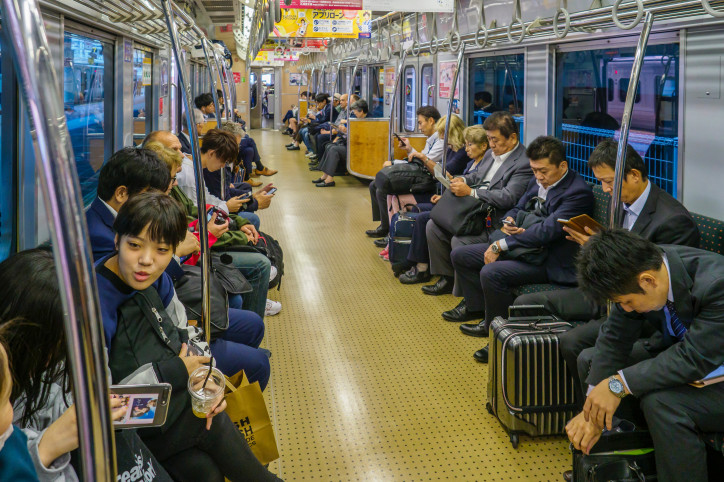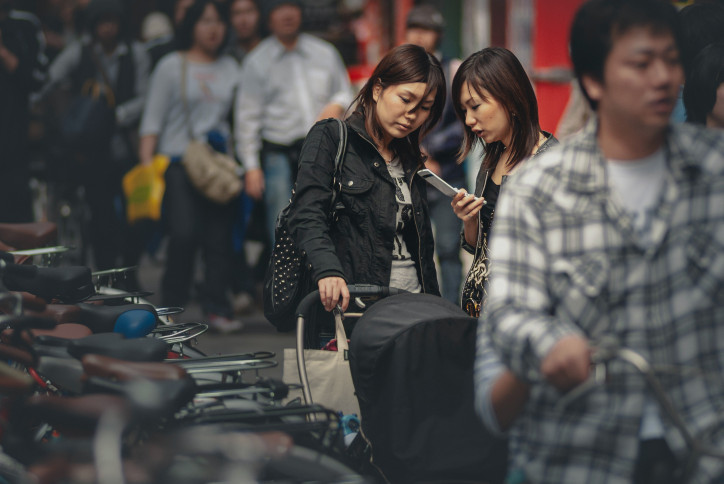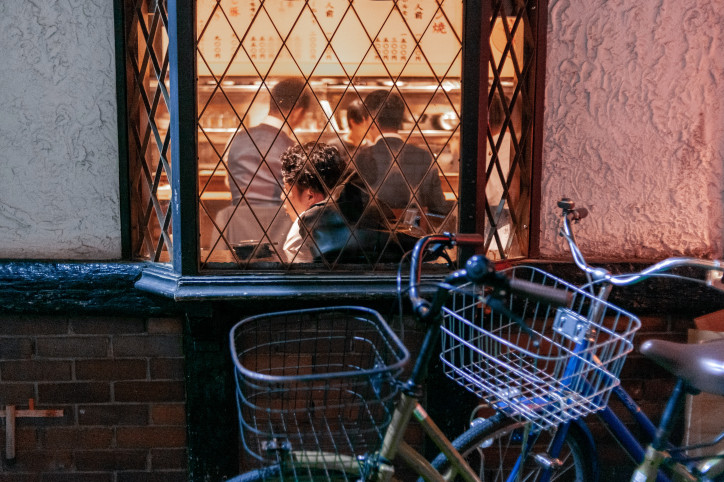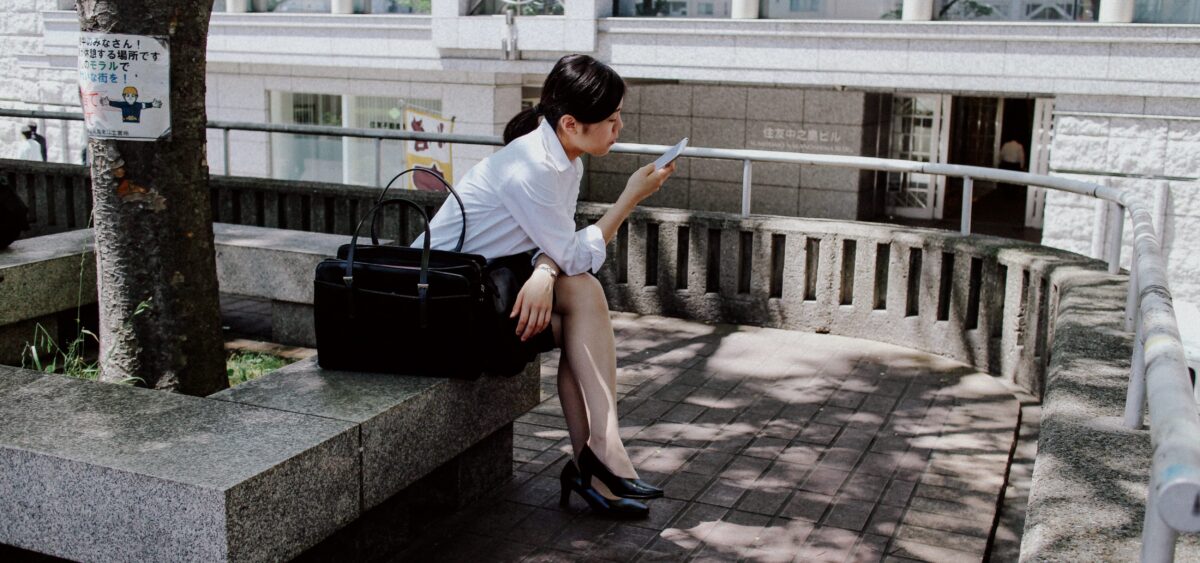
Japanese youth prefer not to think about the future. All the realistic scenarios look very much dystopian and are a depressing forecast for the world. But a lack of different perspectives has taught them one thing – they really do live in the moment. In the spring, young Japanese people have no time for romance. Slim men tie their narrow ties, iron their white shirts, pack documents in black briefcases and – almost identical, perfectly blended-in – go on a hunt. Or rather, they hope to be hunted. Shūkatsu, the ritual spring job-market hunt, is the time of a multi-levelled recruitment process. First, pilgrimages to job fairs, organized by large companies. It’s good to show up and express your interest. Then applications. After that, a maths test and essay writing. Those who manage to emerge victoriously are faced with the actual steep slope: the interview stage.
The search for the right job is crucial because your whole life depends on it – literally. Which is why graduates of Japanese universities apply for jobs in several dozen various companies at the same time. The competition is fierce, and the stakes are as high as they can possibly get. Only a small group will manage to get stable, prestigious and well-paid employment; the kind that allows them to even start thinking about the future. During the spring recruitment fairs, the doors to the best corporations, media companies, law firms, advertising agencies and banks crack open. Whoever slides their foot in will join an esteemed circle, but won’t get to take a breather. It is the beginning of an intense and taxing professional life, filled with sacrifice, overtime and pressure. But those who are left outside will be faced with an even more challenging fate: uncertain and poorly-paid jobs, good enough to survive, but socially disqualifying. Without a good job, there’s no hope for a home and family, not to mention having any dreams. And permanent, lifelong employment – not only in Japan, but all over the world – is becoming increasingly harder to come by. More and more professions look like patches to cover frayed ambition. People often have to juggle two or three jobs in order to live in a city and pay off their student loans. According to the World Bank in 2019, a little over 8% of Japanese people live in rural areas, and housing – either buying or renting property – accounts for the highest life-cost.
Japanese youth, just like other new generations all over the globe, will largely have to expect to become the precariat. The future that awaits them is brittle, rocky, devoid of any hope for fulfilment and certainty. This perspective weighs especially heavy on the shoulders of a society that’s not keeping up with the economic reality, still wearing the corset of expectations from a bygone era. Since the end of World War II, the idea of perfect happiness that dictates the rhythm of life has entirely parted ways with the real-life possibilities available today. Young people experience it the most harshly, and pay the highest price for the deepening conflict between their aspirations and reality. This is why they turn away from the world, choosing online entertainment and pixelated fantasies instead. This is the only kind of life they find affordable and possible.

Home Sweet Home
According to a 2019 report by The Future Laboratory, a trend-forecasting data analysis company, young Japanese people are happy with what they’ve got here and now, trying to enjoy it while it lasts. Even though – in comparison to their peers from other countries – they score rather pessimistically, today’s 15-to-29-year-olds consider themselves happy with their lives more often than the previous generations. There are several reasons for this.
The nation’s wealth, achieved in the 20th century by the collective effort of several generations, still lasts, allowing young people to lead a pretty comfortable life in a reality of advanced services and technologies. As adults, they can still dip into those resources, especially if they live with their parents and at their expense. Without high rents weighing them down, life turns out to be full of leisure and not too expensive. When describing not-so-young unmarried people – still living in their childhood bedrooms surrounded by stuffed animals – Japanese sociologists use very explicit names, such as ‘parasitic singles’. Delayed adulthood is a fact and, regardless of the perception of this phenomenon, an increasingly popular trend.
In Japanese cities, 7-Eleven grocery stores operate 24 hours a day on almost every corner. It’s more than just a shop; 7-Eleven has become a local entertainment centre and a meeting spot of sorts, serving microwaved dishes at any moment. There, you can leave your laundry, pick up a package, buy a lottery ticket and see other people – equally anonymous users of the 24/7 reality.
Another important part of Japanese culture – that is, fashion – also no longer costs an arm and a leg. Inexpensive clothing brands, such as UNIQLO, are gaining popularity. Research indicates that young people find a lot of joy in their phones – they’re genuinely happy to know that smartphones are portals to virtual realities in which they can find everything and anything they’re interested in: music, games, and various subcultures. Smartphones are such an important and intensely present part of their lives that a new term was coined to describe them. Keitai culture refers to all the cultural phenomena and interactions made possible thanks to smartphones. To young people, virtual life is very advantageous: it generates no extra cost, while becoming completely immersive without asking for too much in return. Especially in comparison to the more traditional scenarios of happiness and fulfilment: buying a flat, starting and supporting a family, educating and taking care of children. To choose such a future means to work yourself to death – and, paradoxically, to have no time for the family you are making all those sacrifices for.

In contemporary Japan, youth also means loneliness caused by demographic trends. Only 10% of the population is aged 15 to 24. By the mid-21st century, people aged 65 and over will make up for 40% of society. Even today, it means the young minority and its interests are drastically under-represented at the various levels of the power structure. Political elites are unable to rule with the thought of a distant future in mind; they don’t adopt a wider perspective, expanding beyond the time frame of their own lives. Which is why, despite the alarming prognoses of Japan’s society growing older, the nation still has no effective solutions to stop these negative trends.
The pyramid of desires young people have is shifting in response to the bar being set too high, together with the unequally distributed costs of coexisting with other generations. The lack of real-life perspectives in Japan leads to more and more names for people living in isolation, immersed in virtual realities and uninterested in relationships. When life slams the door in your face, all you’re left with is imaginary worlds to roam.
Buy Now, Pay Later
The ability to live in the moment is a new skill among young Japanese people, developed in response to the painful lack of a future. An admirable attitude, indeed, but it’s also forced. Research shows this optimism vanishes the moment young people are asked about their future. According to data collected by OECD in European countries, an average of 80% of people under the age of 30 believe they will be happy when they’re 40. In Japan, only 40% of young people think that way. According to the Pew Research Center, while Western youth are keen to spend, boosting consumption levels, their peers in Japan are saving up on an exceptional scale. They know the dark hour is coming.

In Japan, the only people eager to buy goods and services are the older demographic. The Japanese economy is still the third-largest in the world (after China and the US), but it’s gradually becoming weaker, and soon, it will lose its most important fuel: the labour force. Japan’s public debt is at a record-high among wealthy countries – according to the International Monetary Fund, it’s sitting at nearly 240%, and could grow by another 10% soon. Right now, this equals $13 trillion. The debt grew by $2 trillion in 2020 alone, mainly due to the government’s special spending, such as economic stimulus packages during the coronavirus pandemic. The country’s debt has been growing since the real estate and stock bubble collapses of the 1990s that ended the era of Japan’s super-growth and technological progress that had been rolling since the end of World War II.
Young people know there is a huge bill looming above their heads – a bill they will have to pay. Even now, this bill is robbing them of an optimistic vision of tomorrow and of the ability to make plans for the future. On top of this, the long-forecasted extinction of Japanese society already began in 2007. In 2020, the country’s population was just under 126.5 million people, which was about 384,000 fewer than the year before – over the course of just one year, Japan’s population shrunk by 0.3%. People aren’t just growing older, there are also fewer children being born. The total fertility rate in Japan is 1.3, while the minimum needed for the reproduction of society is 2.1. The demographic future of the nation looks like an upside-down pyramid, placing a huge responsibility on the shoulders of the few.
In this situation, youth that was once, in the post-war liberal economies, associated with an improved quality of life, new possibilities, social advancement and progress, is now struggling to breathe under the weight of the future that awaits it. The numbers are ruthless. The median age in Japan is now 48.8 years. According to Lynda Gratton – the author of the prognostic book The 100-Year Life and a professor at London Business School, who also worked as an advisor to the Japanese government – almost half of the children born in Japan today will live to be 100 years old or more. Many young Japanese people are aware they will have to work almost until the day they die and support several older members of society each. But who will pay for their future and old age? There are no answers to that.
Who Can Afford Happiness?
An immigration-friendly policy seems to be the simplest economic solution. But according to a 2018 Pew Research Center report (which explored the attitudes of the Japanese towards other countries, as well as towards Japan’s economy and democracy) the number of incomers is tiny. For years now, the balance of emigrants and immigrants has been oscillating around just 1% of the population. And anyway – more importantly for the discussion on the situation of young people – bringing in more foreign workers will not soothe existential anxiety. Young people are concerned with the dominating visions of old age and with the diminishing innovativeness of their country. Moreover, there are cultural barriers to be taken into account. For centuries, Japan isolated itself from the rest of the world, and even today, despite large ethnic minorities being present, the nation still harbours a strong belief about its cultural unity. Japanese traditions, hierarchies and daily rituals make the country less accessible to foreigners, making it an unpopular migrant destination.
The second-most-common response to the population crisis targets women. If not enough children are being born, the government should come up with a special pro-family programme, offering clear, tangible solutions and support. Prime Minister Shinzō Abe – whose (mostly ineffective) efforts to put the brakes down on inflation and stimulate economic growth ended up being nicknamed Abenomics – has been in office for nine years now. It seems like a long enough time to introduce some changes, but the improvement methods announced by his government are being introduced very slowly. Their main goal was to create a childcare system for working mothers – a well-developed net of nurseries and kindergartens. In practice, it turns out to be a thankless task, and still – a shocking result for one of the most developed nations in the world – only 63% of Japanese women have a career, while a staggering 70% of women give up working for at least a decade after having a child.

Here we arrive at the crux of the matter. The perception of social and family roles in Japan remains very conservative, even though 21st-century economics no longer allows such divisions to exist. Japanese women are still expected to be mothers and housewives while the men provide a high-status lifestyle to the entire family. Meanwhile, supporting a household nowadays requires two salaries from two well-earning and professionally-active spouses. Such jobs – big-company, well-paid, long-lasting jobs – are increasingly harder to come by. The unemployment of young people in Japan is twice as high as it is for other demographics. Now it’s becoming very clear why a staggering 40% of men and women in Japan point out the high cost of living as the main obstacle to getting married; the statistics for unmarried people with no sexual experiences has grown to 42% among men and 44% among women. As for singles, the percentage of people who have never been in any relationship is also growing (almost 70% of men and nearly 60% of women). Such data were presented by the National Fertility Survey of Japan in 2015; the next report is expected to come out soon. The reason for the increasing popularity of a relationship-free lifestyle isn’t any particular inclination of the Japanese; it’s just the result of a sober economic calculation.
There is another reason for the population crisis, which seems to be more connected to the cultural norms of this country: an increase in sexual restraint and a decline of interest in physical intimacy in general. It’s a complex issue to tackle. While being famous for its erotic subcultures and fetishes, production of the most-sophisticated sex dolls and the most-advanced virtual-reality avatars that simulate real-life sexual intercourse, Japan does not allow expressing sensuality or erotic expression in everyday life. There’s no hand-holding, no public kissing allowed. In its ‘traditional’ physical form, sex is an aspect of marriage and procreation. The apprehension towards having and supporting children is founded in economic difficulties. But what about marriage itself?
Japanese society is a collective culture in which the idea of ‘us’, along with various other community-centred ideas, have long-trampled the individualist perspective. Marriages were arranged by families or companies that took over most of their employees’ private lives – including after-work drinks, weekend picnics and company holidays. Nowadays, when the norm is being uprooted or changed, young people are left to their own devices, often leaving them confused. They lack the experience and confidence needed for finding good life partners on their own. They also have no positive examples of home life to lean on – a typical marriage meant Mum and Dad functioning separately for years. She would stay at home, and he’d be at work, clocking record overtimes (which have recently been limited by the government, also out of concern for young families), before looking for some reprieve in a bar. The sight of blind drunk men in business suits, sleeping on the streets with their briefcases, is not something unusual. For decades, offices and companies have been effectively replacing their entire world. After a short sleep in a capsule hotel, one can take a shower, get a fresh shirt, and go back to the office. Many men would spend most of their lives hardly ever seeing their wives and children, and only start living at home properly once retired. One could also meet their future wife at the company party, and then spend years going for company holidays with their family. But such companies, arranging their employees’ whole lives, are getting harder to come by. Not to mention that young people are finally brave enough to ask the question: Is it really worth it?
Marriage, motherhood, home-making and obedience are still at the very top of the conservative Japanese value system. Still, twenty-somethings know what they know. Japanese society was the first to experience sudden technological and civilizational acceleration. They are the leaders in the global history race. For years, Japan was the epitome of flourishing robotics and digitalization, which led to intense computerization, miniaturization, and rapid economic growth, especially in the 1970s and 1980s. But the optimistic vision of tomorrow turned out to be just a blink of an eye; it happened and was gone before we knew it. Since the 1990s, the country has been stagnant, just like a sprinter who crossed the finish line and is now jogging on the spot, unsure what to do. When we look at the numbers, we can see economic growth hovering around zero for many years now. As for the image – there are fewer and fewer exciting and trailblazing Japanese brands that could follow up the successes of Casio, Panasonic or Honda from 40 years ago. Culturally, there is a gaping absence of Japanese artists and new technologies among the popular favourites all over the globe.
Innovativeness, so important in the years of the post-war economic miracle, is also diminishing – unsurprisingly so, being the domain of youth. The youngest Japanese don’t want to become independent, creative business owners. They are fuelled by one dispassionate obsession: finding a job in a big corporation or state-owned business. It offers some certainty to clutch onto, knowing it guarantees survival. When all demographic prognoses are turning out to be true, the least inspiring of all human needs is bound to win: people want some stabilization.
We Are All Japanese
Japanese youth are no longer an exception – the rest of the world is heading in a similar direction. While maybe not as starkly visible, all the phenomena listed above are already blossoming here, in Europe. With our ageing Western population, growing global urbanization and people moving to larger cities, natural disasters occurring with growing frequency, fashionable singlehood, plummeting fertility rates, skyrocketing real-property prices, the unfulfilled promise of constant progress, and a pandemic increasing the virtualization of life, we are walking the Japanese path. This isn’t the future we imagined, but this is how it found us. COVID-19 cancelled most of our plans, taking down the development-fuelled belief that the future is ours to shape. During the pandemic, our everyday lives have been drastically rearranged. Right now, the promise of tomorrow is no longer a blurry horizon, inviting us to dream big. Now, it’s a vision – somehow dystopian – that is unfolding as we live it. We live in it.

The Japanese know this. They have already experienced the future followed by the void.
All they were left with were harrowing forecasts for the future and outdated ideals. What future awaits them? Will only robots be able to live up to it? After all, Japan is an expert in robotics. According to the Pew Research Center, an impressive 89% of Japanese society believe that intelligent machines will replace them at work and in daily life. This isn’t a gloomy vision, either. The Japanese have been living with robots for centuries. Already in the 17th century, they were making wooden dolls capable of bow-shooting and serving tea. Even before the 21st century, they would design robotic dogs, capable of communicating their ‘emotional states’ through colour changes. In the current century, the Japanese reality has been enriched by a long parade of humanoid robots, including Erica (who can discuss 20 different topics in a conversation), Robear (a nurse for the elderly), and Kirobo Mini (who accompanies drivers and warns them when they’re speeding).
Perhaps investing skills and money in robots is a precious lesson Japan can offer to others? It’s a testament to acceptance of a future scenario without us, or at least without our dominant present. After all, designing mechanisms often more precise and efficient than humans is an act of faith in humanity, an attempt at solving upcoming problems and improving our quality of life. It’s also an act of accepting our weaknesses. Tomorrow, we will all be old – and once it happens, we will surely appreciate the help of a polite, tireless and virus-immune robot.








